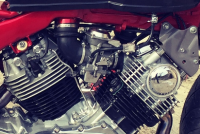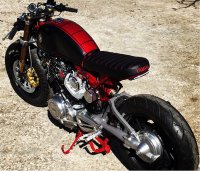Hi all. Was wondering if someone could give me some advice. I have a 1983 xv750 with a rear to front wheel conversion and GSXR1000 front end. This means that the front is dropped in comparison to the standard bike. Seeing the recommended 19mm float heights for my bike seem to be far too high, especially for the front cylinder. Has anyone done a similar bike and can give me some advice?
We noticed you are blocking ads. DO THE TON only works with community supporters. Most are active members of the site with small businesses. Please consider disabling your ad blocking tool and checking out the businesses that help keep our site up and free.
You are using an out of date browser. It may not display this or other websites correctly.
You should upgrade or use an alternative browser.
You should upgrade or use an alternative browser.
XV 750 Cafe Float Levels
- Thread starter Sorcli
- Start date
So far it has been running very badly and hard to start. Seems to me that it's getting too much fuel as it pops through the exhaust a lot. As the carbs were in very bad shape before I overhauled them. I am not 100% sure that the problem is the float level or possibly that the idle screw seat was damaged by the previous owner. Last time it was running it made no difference whether I screwed them all the way in or not. After my latest adjustment, I now have the left carb float height set at about 14mm from the top of the idle jet tower and the other at only 8.5mm. unfortunately I have not had a chance to try it out yet. I thought perhaps someone had been through the same issue and would confirm I'm on the right lines.
Attachments
coyote13
Over 1,000 Posts
Think your pilot might be too big and your main not big enough. Try going back to stock on your pilot, bump the main to about 130. Also, are you sure all of your jet passageways are clear, including the idle air jets?
The float height is tricky since your carbs are at different angles (which you've changed, obviously). Doesn't the XV have different main jets on the front and rear?
The float height is tricky since your carbs are at different angles (which you've changed, obviously). Doesn't the XV have different main jets on the front and rear?
Just as I answered you question about the jets I was checking what standard should be and found that they should be different main jets. 128 and 132, so they don't seem to be right to start with. I trusted 6sigma with what recommend. Thanks for the advice, I dismantled the carbs last Saturday and checked all the passageways including blowing air throug with a large compressor so I'm sure everywhere is clear. I'll try it with the float levels I've set (as its all assembled and ready to try) and if I'm still having trouble I'll try the stock pilot jets, hoping that that will finally resolve my issues.
VonYinzer
Over 10,000 Posts
DohcBikes said:and finally, 6sigma is starting to make my shit list
http://www.6sigmajetkit.com
These folks?
VonYinzer said:http://www.6sigmajetkit.com
These folks?
Yes those folks.
Yes, it pops on deceleration and backfires when I rev it too. It also has throttle lag. It's difficult to keep it idling, but yes you're about right 1000/1400 rpm. I was getting very confused as I seemed to have the signs of it being too rich and to lean at the same time. I blew compressed air down the pilot jet tower with my finger over the outlet hole and they are now definitely both clear, as I even burnt my finger on one carb  . Did the same with the air through the pilot screw hole and it pushed by finger off the top of the idle chat tower. Thanks for all the great advice I will take it on board and let you know the outcome, which could be in a while as I'm away this weekend.
. Did the same with the air through the pilot screw hole and it pushed by finger off the top of the idle chat tower. Thanks for all the great advice I will take it on board and let you know the outcome, which could be in a while as I'm away this weekend.
coyote13 said:What are the stock jet sizes?
This morning on further research I found conflicting evidence regarding the main jet sizes. Clymer says they should be 128 and 130 but Boats.net (which I think I'll trust more) has both of them as 122. If boats are correct it makes more sense that 6sigma gave me 2 each of 125 and 130 (to choose from). This evening after work I will dig out the old jets I removed and see if I can see the size on them, they were in terrible condition so I'm not sure I will be able to.
DohcBikes
Fuck You.
Ain't it funny how someone can tell you what's happening with your bike before you describe the symptoms. Its almost like some people have done this stuff before.
It won't idle because it is trying to idle on the mains, which are going to be very rich at 1200 rpm, then become lean, because they are several sizes too small for the upper end of the throttle positions.
I'll go back and see what intake setup you have. Guessing it's wide open as well.
Ok I see that you have the snorkels hooked up, is there anything in the airbox chamber? Did you modify the intake system in any way whatsoever? These carbs are extremely sensitive to intake velocity due to an already low vacuum signal at idle.
Some people get lucky a couple times, get a custom setup close, and then think they understand jetting. It takes a lot of practice and dyno runs to actually know the results. The important thing for the hobby tunerto remember is that NO AMOUNT OF DISCUSSION tunes a bike. Tuning tunes a bike. Intake, exhaust, and several carb adjustments make for a lot of potential tuning combinations. You have to do your best to reason, but NEVER rule anything out until it runs well.
Float height does not affect tuning greatly until it's way off.
It won't idle because it is trying to idle on the mains, which are going to be very rich at 1200 rpm, then become lean, because they are several sizes too small for the upper end of the throttle positions.
I'll go back and see what intake setup you have. Guessing it's wide open as well.
Ok I see that you have the snorkels hooked up, is there anything in the airbox chamber? Did you modify the intake system in any way whatsoever? These carbs are extremely sensitive to intake velocity due to an already low vacuum signal at idle.
Some people get lucky a couple times, get a custom setup close, and then think they understand jetting. It takes a lot of practice and dyno runs to actually know the results. The important thing for the hobby tunerto remember is that NO AMOUNT OF DISCUSSION tunes a bike. Tuning tunes a bike. Intake, exhaust, and several carb adjustments make for a lot of potential tuning combinations. You have to do your best to reason, but NEVER rule anything out until it runs well.
Float height does not affect tuning greatly until it's way off.
DohcBikes said:Ain't it funny how someone can tell you what's happening with your bike before you describe the symptoms. Its almost like some people have done this stuff before.
It won't idle because it is trying to idle on the mains, which are going to be very rich at 1200 rpm, then become lean, because they are several sizes too small for the upper end of the throttle positions.
I'll go back and see what intake setup you have. Guessing it's wide open as well.
Ok I see that you have the snorkels hooked up, is there anything in the airbox chamber? Did you modify the intake system in any way whatsoever? These carbs are extremely sensitive to intake velocity due to an already low vacuum signal at idle.
Some people get lucky a couple times, get a custom setup close, and then think they understand jetting. It takes a lot of practice and dyno runs to actually know the results. The important thing for the hobby tunerto remember is that NO AMOUNT OF DISCUSSION tunes a bike. Tuning tunes a bike. Intake, exhaust, and several carb adjustments make for a lot of potential tuning combinations. You have to do your best to reason, but NEVER rule anything out until it runs well.
Float height does not affect tuning greatly until it's way off.
The airbox chamber is stock and I even have the rubber liners that were stock. K&N filter on the side of the frame. I haven't messed with a bike for about 30 years so I am way out of practice. Made a couple of cafe racers back in the 80's and jetted the carbs getting a decent result out of them. I haven't had much of a problem the build but I must admit that these carbs have had me working hard. I'm now looking forward to trying out a few more options as you suggested. As you said I just need to try all the options to get it right.
Thanks again for the advice.
Attachments
Put stock OEM jets back in it. Throw the floats in a bowl of gasoline and if they float identically, presume they are ok. Set them at the factory spec. I'd be surprised if the level is different for each carb, but can't speak to it for sure. Like dohc has pointed out, the fuel level has a small effect on tuning (within reason!) and surely is not an issue unless you are wildly out of spec. If your pilot mix screws are not having a big noticeable effect when you run them in and out, your carbs ARE NOT CLEAN!!! Start over from carb cleaning 101. Most of the carb problems that come into my shop are " just cleaned by professionals(ultrasonically cleaned/freshly rebuilt with new kits - etc), so that can't be my problem". Carbs come apart, all non OEM parts replaced (often with "old worn out used" OEM parts - even needles need a zillion miles to really wear, and even then are invariable better than new aftermarket replacements.), get properly cleaned and reassembled. Nearly always that is it. Even if there are modifications that require jet changes, the problems are gone and actual tuning can commence.






